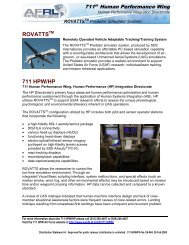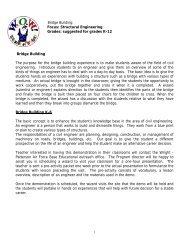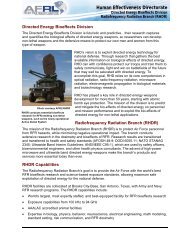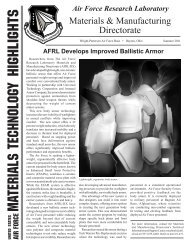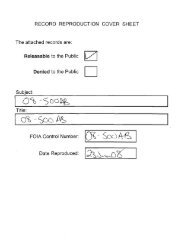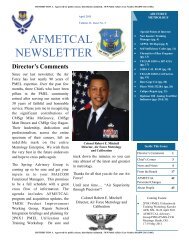TO 00-20-14 30 SEPTEMBER 2011 - Wright-Patterson Air Force Base
TO 00-20-14 30 SEPTEMBER 2011 - Wright-Patterson Air Force Base
TO 00-20-14 30 SEPTEMBER 2011 - Wright-Patterson Air Force Base
- No tags were found...
Create successful ePaper yourself
Turn your PDF publications into a flip-book with our unique Google optimized e-Paper software.
<strong>30</strong> September <strong>20</strong>11 <strong>TO</strong> <strong>00</strong>-<strong>20</strong>-<strong>14</strong>8.4 DUST LEVELS.Dust is an enemy that makes it difficult to make accurate measurements in some measurement areas. The easiest way tokeep dust out of the PMELs calibration and repair area is to have a positive airflow from the environmental system and/orlocate the PMEL within an area of a building, which is relatively dust-free. Ensuring the filters in the ECS are clean isanother major factor in keeping dust levels down. Vacuum cleaning, use of lint free dust cloths, and reduction ofhorizontal plane surfaces minimizes the effects of dust. Devices producing dust or residue particles from grinding orabrasion shall not be installed in, or used in, the calibration and repair area of the PMEL.8.5 NOISE.It is recommended that the noise level in the PMEL be no greater than 70 dB. AFOSHSTD 48-<strong>20</strong>, Occupational Noiseand Hearing Conservation Program, Chapter 3, identifies hazardous noise exposure limits.8.6 VIBRATION.The PMEL areas where calibration is performed shall be maintained as vibration free as possible. The cause of vibration,which affects the repeatability of TMDE, shall be identified and reduced to acceptable levels. The PMEL shall notify theAFMETCAL Technology Applications and Electronic Engineering sections of any vibration problems that cannot besolved. An acceptable vibration level for a PMEL is anything less than 0.25 μm (10 μin) from 0.1 to <strong>30</strong> Hz (displacementpeak). The maximum acceleration peak is 0.<strong>00</strong>1G for frequencies from <strong>30</strong> Hz to 2<strong>00</strong> Hz.8.7 ELECTROMAGNETIC INTERFERENCE (EMI)/RADIO FREQUENCY INTERFERENCE (RFI).EMI that causes degradation of equipment performance and disruption of calibration shall be suppressed or eliminated tothe maximum extent possible.8.7.1 New PMEL Facilities. The effects of EMI to PMEL equipment shall be minimized through the selection oflocations for new PMEL facilities where the ambient radio frequency (RF) field strengths from 10 kHz to 18 GHz shallnot exceed 1 V/m external to the proposed facilities. An electromagnetic compatibility (EMC) survey shall be performedfor each proposed PMEL facility site. The results of the EMC survey shall be used to determine site suitability. Thesurveys shall be performed by the 85 EIS/SCYM in accordance with ACCI 33-104, Engineering Installation (EI)Procedures. Upon completion of the EMC survey, a formal engineering report shall be supplied to both the PMELcustomer and AFMETCAL Plans & Analysis Section8.7.2 Existing PMEL Facilities. EMI that causes degradation of equipment performance or disruption of calibration atexisting sites shall be eliminated or suppressed to the maximum extent possible. The PMEL shall report apparent EMIproblems to the 85 EIS/SCYM in accordance with AFI 10-707, <strong>Air</strong> <strong>Force</strong> Spectrum Interference Resolution Program.The 85 EIS shall provide on-site assistance in determining the source(s) of the EMI and propose solutions for theelimination or suppression of the EMI. Upon completion of the EMI survey a formal engineering report shall be providedto both the PMEL customer and AFMETCAL Plans & Analysis Section.8.7.3 Obtaining Related Assistance. An EMI or EMC survey shall be obtained through a request to the 85 EIS/SCYM atthe following location:85 EIS/SCYM Voice: DSN 597-39<strong>20</strong> Comm 228-377-39<strong>20</strong>670 Maltby Hall Dr, Ste 234 FAX: DSN 597-3956 Comm 228-377-3956Keesler AFB MS 39534-26338.8 LIGHTING.8.8.1 General Lighting. The general lighting for all occupied areas shall be balanced to minimize shadows and produceuniform illumination.8.8.2 Minimum lighting. Minimum lighting levels are specified to reduce the need for additional lighting fixtures in thecalibration and repair area because they become dust collectors and can interfere with setting up a measurementcapability. Proper illumination is required to perform precision measurements.8.8.3 Uniform Illumination. Uniform illumination is defined as a distribution of light at the measured height where themaximum and minimum general illumination in the immediate work area (e.g., bench top, test set up) is not more thanone-sixth above or below the average illumination in the area.8-5




